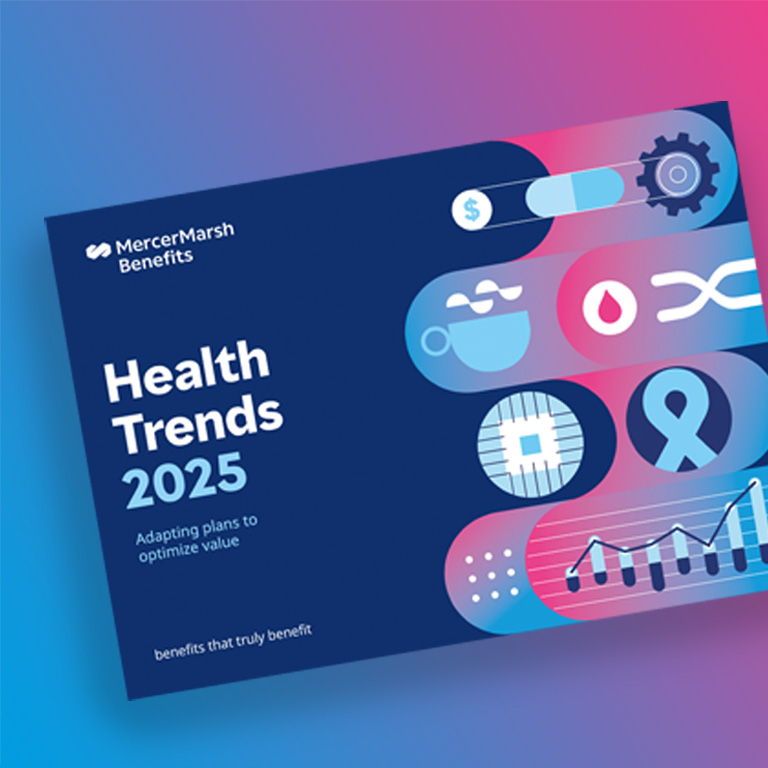
By Ella Mansfield ,
Principal, Mercer Marsh Benefits
12/10/2021 · 4 minute read
The 2021 Global Risks Report, published by the World Economic Forum in collaboration with Marsh McLennan, has identified ‘Deteriorating Mental health’ as the second highest risk to Australian workplaces.
Since the COVID-19 pandemic, there has been an explosion of research being conducted across the psychological sciences. A meta-analysis of the research published to date has demonstrated that anxiety, depression, and distress increased dramatically in the early months of the pandemic. Meanwhile, suicide rates, life satisfaction, and loneliness remained largely stable throughout the first year1.
What we are seeing in the second year is some significant mental health trends impacting very specific cohorts of Australians – particularly, young people (aged 13-30 years) and our older generations (70 and over).
Despite the significant mental health impacts to both of these generations, we cannot discount the flow on effect to the families of both young and older Australians. There are significant mental health and stress impacts on the familial support systems, and the role of the carer has really come into focus. Many working age adults are having to navigate home schooling, keeping kids at home engaged, care for aging parents, juggling work responsibilities and remote working challenges, and navigating the changing pandemic landscape – with the constant flow of snap lockdowns and updates to restrictions.
Workforce exhaustion was identified in Mercer Marsh Benefits’ The Five Pillars of People Risk Report 2021 as the third highest risk amongst all people risks, and is an escalating concern that requires immediate attention. When asked ‘to what extent is your organisation currently addressing this risk?’ respondents rated it 14th place on the list of organisational priorities, behind other items like data privacy, labour & employee relations, and communicable health conditions. Besides the long term health risks of workforce exhaustion, there is also an organisational cost to ignoring this issue, including toxic work cultures, low employee morale and engagement, high employee turnover, low productivity and higher medical claims.
Since the pandemic, we have acquired a new glossary of terms to describe the various states of workforce exhaustion:
Languishing: While not all Australians are feeling levels of distress and discomfort that would warrant a mental health diagnosis, many are experiencing the effects of Pandemic Languishing. Some are calling Languishing the dominant emotion of 2021.
“Languishing is the void between depression and flourishing — the absence of well-being” psychologist Adam Grant wrote in the New York Times2. Languishing dulls your motivation, disrupts your ability to focus, which increases the workload (as things pile up) but significantly reduces your motivation to get through it. In addition, while languishing is not a diagnosable mental health condition, it appears to be a significant risk factor for developing mental illness.
Emotional Exhaustion: Emotional exhaustion is this sense of overwhelm. Overwhelmed to the point where you feel like you don't have the capacity to deal with life anymore. It's physical tiredness. It's mental tiredness. It's difficulty concentrating. It's all the things that we experience when we’ve reached our limit or capacity.
Burnout: Burnout was the unofficial 2020 mental health buzzword. According to the World Health Organisation, burnout is specifically a form of work-related stress that has not been successfully managed. Common symptoms include feelings of energy depletion, cynicism about one’s job, and reduced professional efficacy.
Alonely: Aloneliness is the opposite of loneliness. It's the dissatisfaction that comes from not spending enough time by yourself. During the pandemic, when home, school and office life has been combined in one space, this feeling is becoming more common.
The pandemic ‘experience’ is very unique for everyone and Australian workplaces need to provide solutions that meet these varied needs of their workforce. Organisations should take a human-centred design approach when developing a curated mental health and wellbeing framework that is data-led and research-informed.
The Mercer Global Talent Trends 2021 Report has indicated that Australian Workplaces are craving initiatives that provide benefits to employees that address mental health or emotional health issues; train managers to identify mental health issues and support with early help seeking activities, and provide access to digital or remote mental health services. Interestingly, there has also been an identified need for organisations to take a more coordinated and multi-year approach to mental health and wellbeing, with the implementation of an overarching strategy or framework – rather than a quick-fix or tokenistic approach to employee wellbeing.
Mercer Marsh Benefits have identified two primary initiatives that can assist in managing mental health risks at an employee level:
COVID-19 has pushed mental and physical wellbeing up the corporate agenda, but organisations must tread carefully. Poorly designed plans or “quick-fix” solutions are likely to cost more money and yield little to no return on investment with the added potential to undermine health and employee engagement. An evidence-based approach that understands and addresses the specific needs of the workforce is the key to successful program design, measurement and implementation. If you would like to learn more, speak to your broker at MMB or contact us here.
1 Mental Health During the First Year of the COVID-19 Pandemic: A Review and Recommendations for Moving Forward - The Lancet’s COVID-19 Commission Mental Health Task Force. Lara B. Aknin, Jan Emmanuel De Neve, Elizabeth W. Dunn, et al.
2 There’s a Name for the Blah You’re Feeling: It’s Called Languishing by Adam Grant, New York Times. Published 19 April 2021

Article
13/10/2024
This webpage is not intended to be taken as advice regarding any individual situation and should not be relied upon as such. The information contained herein is based on sources we believe reliable, but we make no representation or warranty as to its accuracy. Marsh shall have no obligation to update this publication and shall have no liability to you or any other party arising out of this publication or any matter contained herein.
Any statements concerning actuarial, tax, accounting, or legal matters are based solely on our experience as insurance brokers and risk consultants and are not to be relied upon as actuarial, accounting, tax, or legal advice, for which you should consult your own professional advisors.